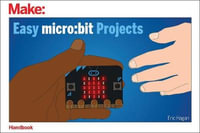
Paperback
RRP $95.00
$47.75
50%OFF
Ships in 15 to 25 business days
ISBN: 9780596005627
ISBN-10: 0596005628
Series: O'Reilly Ser.
Published: 6th January 2004
Format: Paperback
Language: English
Number of Pages: 418
Audience: Professional and Scholarly
Publisher: O'Reilly Media, Inc, USA
Country of Publication: GB
Edition Number: 3
Dimensions (cm): 22.86 x 17.15 x 2.54
Weight (kg): 0.65
Shipping
| Standard Shipping | Express Shipping | |
|---|---|---|
| Metro postcodes: | $9.99 | $14.95 |
| Regional postcodes: | $9.99 | $14.95 |
| Rural postcodes: | $9.99 | $14.95 |
Orders over $79.00 qualify for free shipping.
How to return your order
At Booktopia, we offer hassle-free returns in accordance with our returns policy. If you wish to return an item, please get in touch with Booktopia Customer Care.
Additional postage charges may be applicable.
Defective items
If there is a problem with any of the items received for your order then the Booktopia Customer Care team is ready to assist you.
For more info please visit our Help Centre.
You Can Find This Book In
This product is categorised by
- Non-FictionComputing & I.T.Operating SystemsMicrosoft (Windows) Operating SystemsWindows 2003
- Non-FictionComputing & I.T.Computer Programming & Software DevelopmentProgramming & Scripting Languages
- Non-FictionComputing & I.T.Computer HardwarePersonal Computers
- Non-FictionComputing & I.T.Digital Lifestyle & Online World: Consumer & User GuidesInternet Guides & Online Services
- Non-FictionComputing & I.T.Computer Networking & Communications
- Booktopia Publisher ServicesJohn Wiley & Sons Publishers UK
























